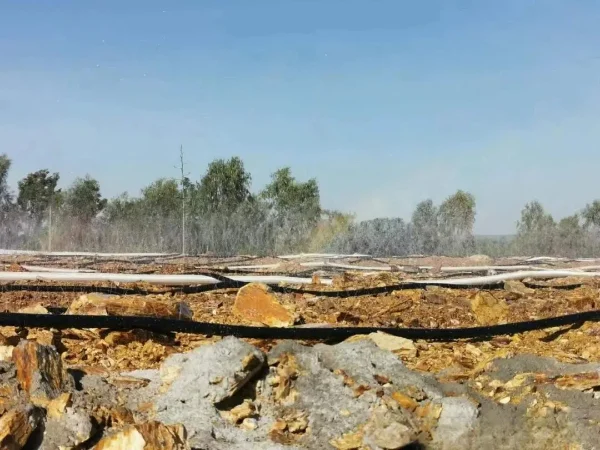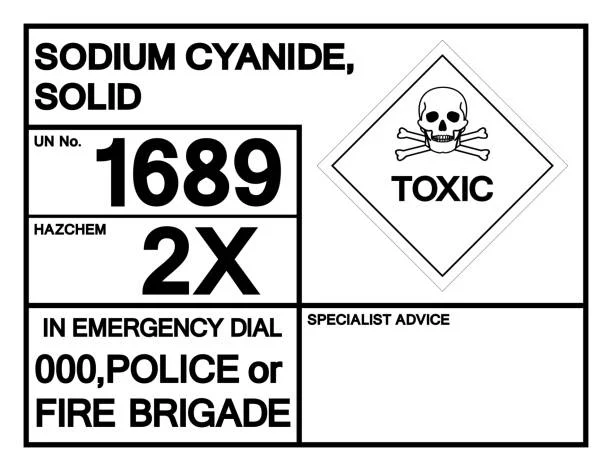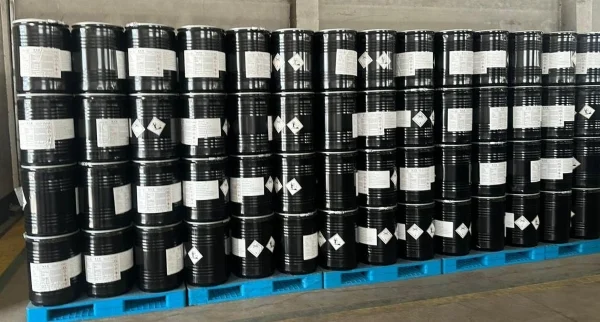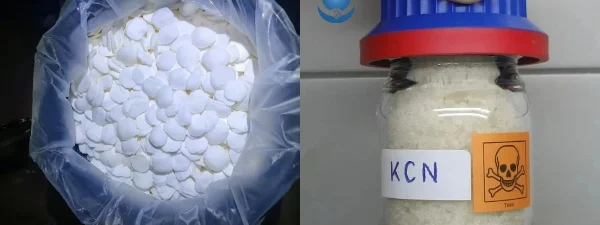
In the field of mineral processing, especially in the cyanidation process for gold and silver extraction, adjusting the Sodium Cyanide dosage according to the ore particle size is crucial for optimizing the leaching efficiency and reducing production costs. This article aims to provide a comprehensive guide on how to make such adjustments.
The Influence Mechanism of Ore Particle Size on Cyanidation Reaction
Surface Area and Reaction Kinetics
Finer ore particles have a larger specific surface area. When sodium cyanide solution reacts with the ore, a larger surface area allows for more contact points between the cyanide ions and the target minerals (such as gold or silver). According to the reaction kinetics theory, the reaction rate is proportional to the surface area of the reactants. For example, in a study on gold cyanidation, it was found that when the ore particle size was reduced from a coarser size to -38 μm with a content ratio of 75%, the leaching rate of gold increased significantly. With finer particles, more gold atoms on the surface are exposed to the cyanide ions, facilitating a more efficient reaction.
Coarser particles, on the other hand, have a smaller surface area available for reaction. The cyanide ions can only react with the outer layer of the particles, and the diffusion of cyanide ions into the interior of the coarse particles is slow. This leads to a lower overall reaction rate and incomplete leaching of the target minerals inside the particles.
Diffusion Barrier
In the case of fine - grained ores, the distance that the cyanide ions need to diffuse to reach the target minerals is shorter. This reduces the diffusion resistance and enables a faster reaction. As the ore particle size increases, the diffusion path of cyanide ions through the porous structure of the ore particles becomes longer. The presence of gangue minerals in the particles can also act as a diffusion barrier. For instance, if there are layers of non - reactive gangue minerals around the gold - bearing minerals in a coarse particle, it will take much longer for the cyanide ions to penetrate and react with the gold, resulting in a lower leaching efficiency.
Measurement of Ore Particle Size
Sieving Analysis
Sieving is a common and straightforward method for determining ore particle size. A set of standard sieves with different mesh sizes is used. The ore sample is placed on the top sieve of the stack, and then the stack is mechanically shaken for a certain period. The particles that pass through each sieve are collected and weighed. By calculating the mass percentage of particles retained on each sieve, the particle size distribution of the ore sample can be obtained. For example, in a gold ore processing plant, if the ore is sieved through a series of sieves with mesh sizes of 200. 325. and 400. the percentage of particles smaller than each mesh size can be determined, which helps in understanding the fineness of the ore.
Laser Diffraction Particle Size Analysis
This is a more advanced and accurate method. Laser diffraction analyzers work based on the principle that when a laser beam passes through a dispersed particle system, the particles will scatter the laser light. The angle and intensity of the scattered light are related to the particle size. By measuring the scattered light, the instrument can calculate the particle size distribution of the ore sample. It can provide detailed information about the entire particle size range, including very fine particles that may be difficult to accurately measure by sieving. This method is especially useful when dealing with ores with a wide range of particle sizes or when high - precision measurements are required for optimizing the cyanidation process.
Principles and Methods for Adjusting Sodium Cyanide Dosage
General Principles
Proportional Relationship within a Certain Range
In general, within a certain range, the amount of Sodium cyanide added is proportional to the surface area of the ore particles. As the ore particle size becomes finer (larger surface area), more sodium cyanide is required to ensure complete reaction with the target minerals. However, this relationship is not linear indefinitely. When the amount of sodium cyanide exceeds a certain level, the leaching efficiency may not increase significantly, and it will cause waste of chemicals and increase production costs.
Ore Characteristics Consideration
Different types of ores have different chemical compositions and structures. Some ores may contain minerals that consume cyanide ions, such as certain sulfide minerals. In such cases, even for the same particle size, more sodium cyanide may be needed to achieve the desired leaching effect. For example, if an ore contains a high proportion of pyrite, the pyrite may react with the cyanide ions and oxygen in the solution, consuming cyanide. So, the cyanide dosage needs to be adjusted according to the specific mineral composition of the ore.
Adjustment Methods
Laboratory Testing
Before large - scale industrial production, laboratory tests should be carried out. Prepare ore samples with different particle sizes through grinding and sieving. Then, conduct cyanidation leaching tests on these samples with different dosages of sodium cyanide. Measure the leaching rate of the target minerals (e.g., gold or silver) under different conditions. By analyzing the experimental data, establish a relationship between ore particle size, sodium cyanide dosage, and leaching rate. For example, for a gold ore with a particle size of -200 mesh (about 74 μm), the laboratory test may show that when the sodium cyanide dosage is increased from 1 kg/t to 2 kg/t, the gold leaching rate increases from 70% to 85%, but further increasing the dosage to 3 kg/t only increases the leaching rate to 87%. This data can be used as a reference for industrial production.
Online Monitoring and Adjustment in Industrial Production
In industrial production, online particle size analyzers can be installed to continuously monitor the particle size of the ore entering the cyanidation process. Based on the pre - established relationship between particle size and sodium cyanide dosage from laboratory tests, an automatic dosing system can be adjusted in real - time. For example, if the online particle size analyzer detects that the average particle size of the ore has become finer, the automatic dosing system can increase the sodium cyanide dosage accordingly to maintain the optimal leaching efficiency.
In conclusion, adjusting the sodium cyanide dosage according to the ore particle size is a complex but essential task in the cyanidation process. By understanding the influence mechanism of ore particle size, accurately measuring the particle size, and following the appropriate adjustment principles and methods, the mineral processing industry can improve the efficiency of cyanidation leaching, reduce chemical consumption, and enhance overall economic and environmental benefits.
- Random Content
- Hot content
- Hot review content
- Toxicity Assessment of Sodium Cyanide and Relevant Hazard Prevention Measures
- Industry Grade Electron grade 98% Sulfuric Acid H2SO4 Sulphuric Acid Battery Acid Industrial Sulfuric Acid
- High Quality Sodium silicate 99% Water glass
- The Essential Guide to Sodium Cyanide: Usage Cases and Sourcing
- Powdery emulsion explosive
- Sodium bisulfite 99% High Quality Factory Supply
- Magneto Electric Detonator(Anti stray current)
- 1Discounted Sodium Cyanide (CAS: 143-33-9) for Mining - High Quality & Competitive Pricing
- 2Sodium Cyanide 98% CAS 143-33-9 gold dressing agent Essential for Mining and Chemical Industries
- 3Sodium Cyanide 98%+ CAS 143-33-9
- 4Anhydrous Oxalic acid 99.6% Industrial Grade
- 5Oxalic acid for mining 99.6%
- 6Soda Ash Dense / Light 99.2% Sodium Carbonate Washing Soda
- 7Reagent Grade/Industrial Grade Hydrochloric Acid min.31%
- 1Sodium Cyanide 98% CAS 143-33-9 gold dressing agent Essential for Mining and Chemical Industries
- 2High Quality 99% Purity of Cyanuric chloride ISO 9001:2005 REACH Verified Producer
- 3 High-Quality Sodium Cyanide for Leaching
- 4Powdery emulsion explosive
- 5Industry Grade Electron grade 98% Sulfuric Acid H2SO4 Sulphuric Acid Battery Acid Industrial Sulfuric Acid
- 6Colloidal emulsion explosive
- 7sodium hydrosulfide 70% flakes used Mining Industry











Online message consultation
Add comment: